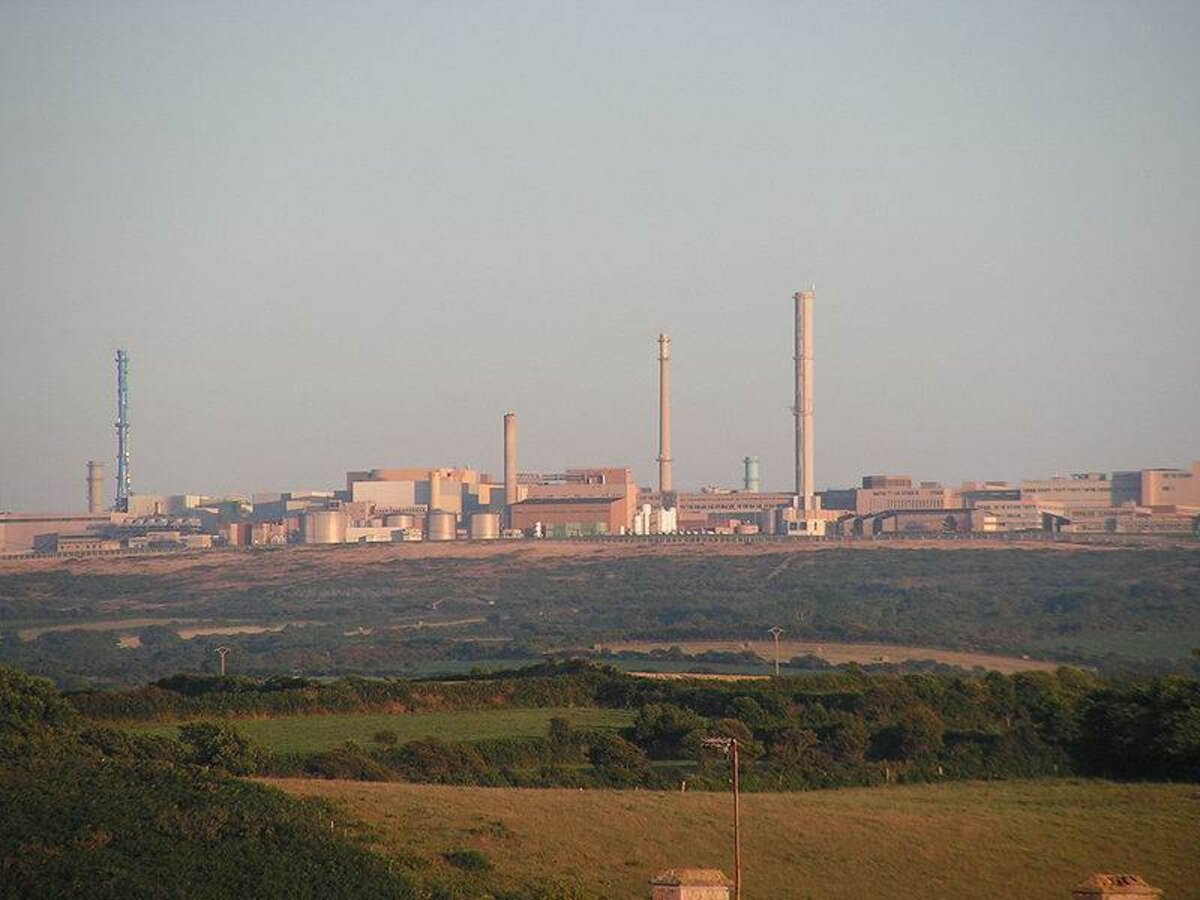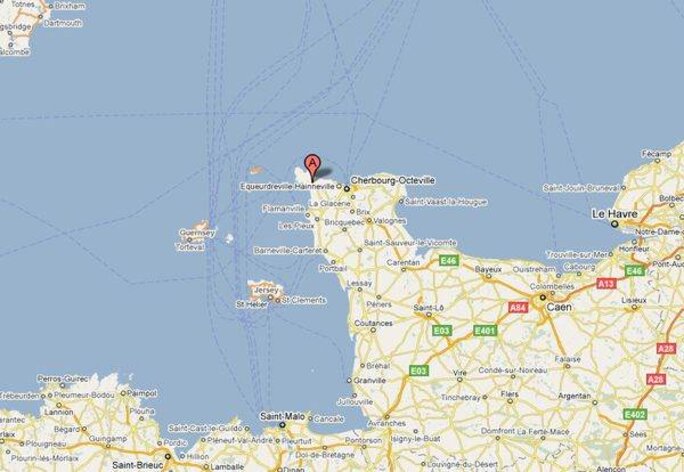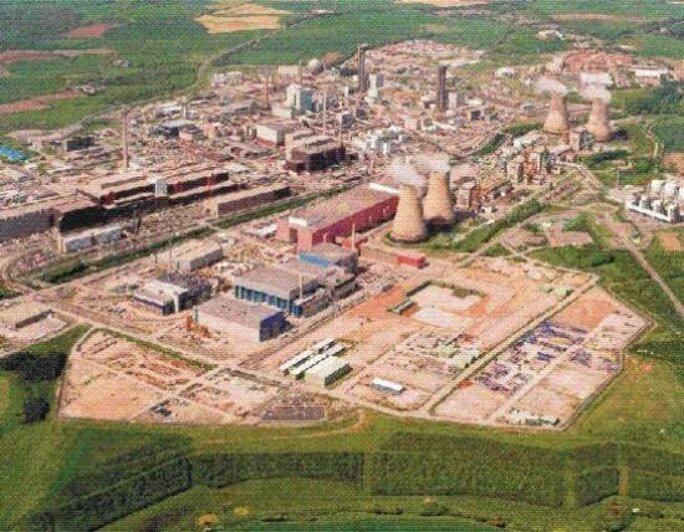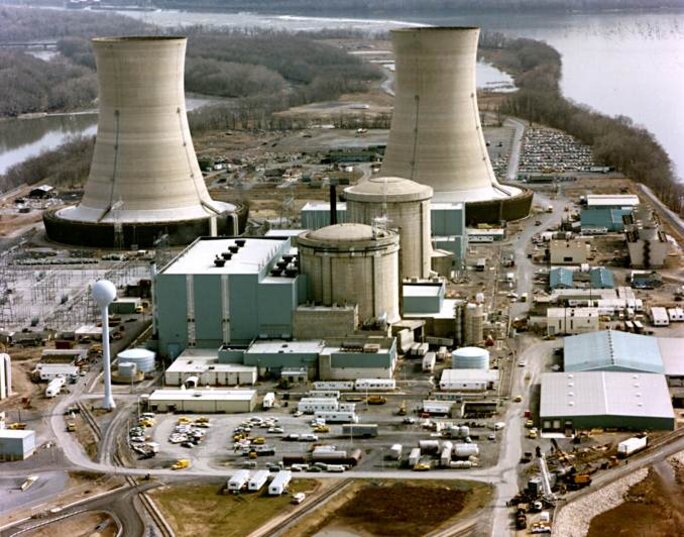The disastrous meltdown at the tsunami-hit Japanese nuclear power plant of Fukushima in March threw the future of the nuclear industry worldwide into doubt amid public concern over the vulnerability of plants to natural disasters. But a lesser-publicized danger inherent to nuclear plants, and dismissed by industry experts for decades, is that of the low-level radiation they constantly emit. A recent and largely-overlooked report published by the French nuclear safety authority, the ASN, has confirmed the potential hazard of low-level radiation to local populations, and the implications are alarming. Patricia Brett reports.
-------------------------
Last month, the French nuclear safety authority published a report in which it recognised that the existence of a leukaemia cluster around the nuclear waste reprocessing plant of La Hague, in Normandy is "possible". The study by the Autorité de Sûreté Nucléaire (ASN) was highly significant because radioprotection experts in France and abroad have long regarded the dangers of low-level radiation as negligible.

Enlargement : Illustration 1

At La Hague, the principle threat -albeit officially regarded as potential - comes from tritium, a low-level radioactive hydrogen regularly released by the plant. But the "possible" serious health effects at La Hague is cause for wider concern, because tritium is released by a range of nuclear installations, including the 19 nuclear power plants across France, and its production and release into the environment is expected to rise in the future.
In their report, entitled Nuclear Installations and Childhood Leukaemia, the ASN experts examined the findings of 198 studies in ten countries. They confirmed that leukaemia clusters had been found around the British nuclear reprocessing plant of Sellafield, at the now-shut Dounreay test reactor in Scotland and Germany's Kummel nuclear power plant.
The ASN called for international cooperation to improve the methodology of studies because, it found, current available data is difficult to assess. Indeed, closer examination of the sometimes wildly different methods and conclusions of international studies make that call an urgent one.
The admission that exposure to low-level radiation may be placing populations close to nuclear plants at a serious health risk comes after decades of denial. "It's a false problem," said Jean-Pierre Moroni, then-deputy director of the Service Central de Protection Contre les Rayonnements Ionisants, a predecessor of the ASN, in a US radio documentary in 1989 (1). Low doses of radiation were not harmful, he continued, "like it is not harmful to drink just a drop of wine. When you drink just a drop of wine what is the danger? [...] of course there is no danger. And so it is for radiation".
Studies 30 years ago which raised the dangers of low-level radiation were discounted because they "did not fit the paradigm" says Dr. Patrick Smeesters, a Belgian radioprotection expert who sits on the Euratom Committee of Experts, advisors on nuclear standards to the European Commission.
Radioprotection of the public was originally based on two assumptions: that serious accidents resulting in large scale contamination are improbable and that exposure to low-level radiation causes insignificant damage. The first of these was eroded by the accidents at Three Mile Island (1979), Chernobyl (1986) and Fukushima (2011). The second is seriously undermined by a growing body of evidence, much of it from Chernobyl-contaminated pockets of Ukraine and Belarus, which shows that the potency of low-level radiation is underestimated by those charged with protecting the public - especially those most vulnerable to radioactive damage, infants and babies in the womb.
The Institut de Radioprotection et de Sûreté Nucléaire, IRSN, the ASN's technical arm, has been studying the long-term effects of the 1986 Chernobyl nuclear plant disaster. ‘‘We expected leukaemia in children. Instead we found that infants were more prone to thyroid cancer - and much sooner than we'd expected, only five years after the accident rather than 10 to 15 years as we'd thought,'' Jean-René Jourdain, head of internal dosimetry at the IRSN told the International Herald Tribune in 2008.
Some studies in Chernobyl-contaminated Ukraine show a connection between chronic exposure to low-level radiation and the risk of birth defects, especially neural tube defects which range from treatable spinal cord disorder to the fatal condition of failure to develop a brain (anencephaly). A high rate of conjoined or Siamese twins was also detected in the area studied.
Other data found that children in the contaminated areas of southern Belarus showed higher ingested doses of radioactive caesium 137 and suffered from more chronic and more severe diseases than children in non-contaminated areas. "Recurrent respiratory and gastrointestinal infections as well as endocrine disorders and cataracts are common," the IRSN study reported. "Other frequent findings include increased fatigue or apathy and chest pain associated with cardiovascular symptoms, such as unstable blood pressure or arterial hypertension." the study says.
-------------------------
1: 'Full Steam Ahead: French Nuclear Power', produced by Patricia Brett for Soundprint.
None of these outcomes was forecast by veteran radioprotection authorities and many are unable to re-evaluate their long-held beliefs. A controversial German study which sparked the ASN's interest in low-level radiation is an illustration. A 1997 study found a rise in leukaemia in the vicinity of the Krümmel nuclear power plant. After the methodology of the study was questioned, a new study was commissioned by the German Federal Office of Radiation Protection (BfS). Released in 2007, the new study found that for all 16 German nuclear power plants, the risk of cancer or leukaemia to children under five years-old increases the closer they live to the plant.
Within a five-kilometre radius, the risk of cancer rises by 60% and that of leukaemia increases by 100%. The experts who carried out the study ruled out radiation exposure as a cause saying that the levels of exposure were too low. Because of the controversy caused by those conclusions, another group of experts was called in to review the study results. They determined that radiation exposure could not be ruled out. Yet, the BfS maintains the original conclusions; that other factors must be responsible.
Dr. Peter Kaatsch, principal investigator in the study and head of the German Child Cancer Registry agrees. "My idea," he explains, "is that nuclear plants are located in rural regions where, for example, pesticides are higher than in other regions. And they produce electricity so that electromagnetic fields are also a little bit higher in this region than in other regions. And [the poor] are living in these regions where nuclear plants are located. And one hypothesis for childhood leukaemia is that immune systems are very responsible for development of leukaemia - for example, breast feeding, vaccinations and size of families. And I suppose that many factors that can develop leukaemia are concentrated in these regions where the nuclear plants are located."

Enlargement : Illustration 2

Indeed, the ASN report this November also insisted on the other many possible origins of childhood leukaemia, adding that cancer can take years to develop and establishing proof of origin can be difficult.
Radioactive hydrogen, or tritium, is the most common low-level radioactive pollutant regularly released by nuclear installations either into the air or as a liquid into a local river, canal or sea. Most radioactive discharges are regulated. Nuclear installations benefit from annual discharge levels set by national regulators which vary from plant to plant and from country to country. The La Hague nuclear reprocessing plant in north-western France is allowed to discharge 18 500 terabecquerels (1TBq =1012Bq) of liquid tritium annually, mostly into the English Channel (1). A garden variety nuclear power plant such as the one at Nogent-sur-Seine, located 100km upstream from Paris, is allowed to dump 80 TBq per year into the river Seine. This is much more than its allowance for another low-level radioisotope, carbon 14 for which the level is set at 190 gigabecquerels (1GBq=109 Bq).

Tritium is pesky because it bonds easily with other hydrogen particles and these, as a building-block of the planet - found in water, humans, plants and animals -gets into everything. Mostly, tritium gets into water, which, as was amply demonstrated at Fukushima Daiishi, is hard to capture and once stored, tends to leak into both surface and ground water sources.
Concerned by British studies and by an expected rise in tritium discharges, the ASN decided to look more closely at tritium. A number of experts examined the data relative to the effects of tritium on humans, while others looked at the industrial aspects of tritium production, reduction, storage and discharge. Their conclusions were published in 2010 as a ‘Tritium White Paper'.
The British studies showed that tritium finds its way into the food chain, 'bioamplifying' - that is, becoming more toxic at each step - and wends its way onto our dinner tables. Research carried out in the highly tritium-polluted Cardiff Bay and the Irish Sea (off the Sellafield nuclear reprocessing plant) showed that tritium concentrates in certain types of mollusc and flat fish such as flounder.
Similar studies around France's La Hague plant yield more reassuring data, despite the fact that it was discharging five times as much tritium as Sellafield over the past ten years. But, the ASN White Paper reported, this could be explained by the differences in sampling methods. At Sellafield, samples are drawn from areas located seven kms on either side of the release pipe. The samples for La Hague are culled from a zone that extends 80 kms to the west and 50 kms to the north of the release pipe, providing haphazard data that is difficult to analyse.
Furthermore, La Hague plant owner and operator Areva samples a type of algae that is known to be among the least sensitive to radiation rather than the flounder, flat fish, lobsters, mussels and other shellfish tested at Sellafield, the White Paper noted.
-------------------------
1: Understanding radioactivity is complicated by the many ways of measuring it. The most basic measurement concerns the activity of the element, how many radioactive atoms disintegrate over a period of time. This can be measured in becquerels. One becquerel is equal to one disintegration per second.
Once bonded tritium gets into the body, recent studies show that it can cause damage much more serious than previously thought, especially to unborn babies, the White Paper warned. Because tritium particles are so tiny, they can easily pass through the placenta barrier and irradiate the foetus.

In its 2007 recommendations (1), the International Commission for Radiological Protection (ICRP) confirmed that irradiation in the early stages of pregnancy, before the embryo is implanted, often leads to miscarriage. Those that survive, risk "tissue injury and malformations," the ICRP says, along with other effects including "severe mental retardation," diminished IQ, cancer and genetic mutations.
Some three per cent of tritium is produced by cosmic rays but most originates with the nuclear industry, particularly reprocessing plants. The luminous paint industry is also responsible for high levels of tritium, including in Cardiff Bay. Tens of thousands of terabecquerels end up in the North Atlantic each year, according to the Convention for the Protection of the Marine Environment of the North-East Atlantic (OSPAR).
Countries with nuclear industries usually follow dose limit recommendations set by the ICRP. These are "often considered the gold standard against which radiological protection requirements are compared," says Christopher Clement the Commission's current Scientific Secretary.
Historically, radioprotection has lagged behind reactor safety. The President's Commission investigation into the 1979 nuclear accident at the Three Mile Island (TMI) nuclear plant was dismayed to discover that both the plant operator and the nuclear regulator, the Nuclear Regulatory Commission, considered that the consequences of an accident beyond a two mile (3.2kms) limit outside the plant "were so unlikely as not to be of serious concern".

Enlargement : Illustration 5

Since TMI, the attitude to radioprotection has improved, Clement says, as occupational safety has become more important generally. "But something to remember is that radioprotection is just one piece of the puzzle," he cautions, "it can't be considered separately from regular occupational safety or protection from chemical exposure. Or slips and falls. And it can't be considered separately from nuclear safety." And while improved radioprotection is a good thing, he hopes "it never, like any little piece of safety, becomes so overwhelmingly important that the other parts are dismissed. It's part of a whole."
The ICRP recommendations are non-binding and it has no power to impose sanctions. Furthermore, use of the ICRP's dose limits is made to be flexible, each country is free to "tweak them slightly to meet their local conditions," Clement explains. This is perfectly acceptable as long as the principle of As Low as Reasonably Achievable (ALARA) is respected. Thus if radiation levels rise due to an accident that can't be controlled, raising acceptable dose levels is compatible with ALARA.
Dose limits are based largely on studies of survivors of the 1945 atomic bombs dropped at Hiroshima and Nagasaki. Complex calculations of the effects of exposure to a range of types of radioisotope for various lengths of time are performed to establish effective dose limits for a "Reference Person".
The ICRP considers that radiation-induced cancers are probable at any level of exposure but that the risk increases sharply above a certain limit, which is why it is more tolerant of low-level exposure (1). In sum, chronic irradiation of part of the population and the resulting cancers are viewed as part of the trade-off for enjoying the benefits of nuclear power.
One major problem with ICRP methodology is that Japanese bomb victims received one short, external exposure to high levels of radiation while most people are subject to chronic, internal low-dose exposure, Clement admits, although he says that other studies are also used to calculate dose limits. Yet, ICRP publications make it clear that data is lacking on this subject (1).
-------------------------
1: References to ICRP policies and documents are drawn from ICRP Recommendations 30, 60 and/or 103 (click here for more).
Accepted dose levels for all types of radiation have been steadily reduced over the years. The ICRP's acceptable annual dose was set at 1000 millisieverts (mSv) in 1928 (1). This was revised in 1957 to 50mSv for nuclear workers and 5mSv for the public. These recommendations were revised in 1990 to 20mSv for workers and 1mSv for the public. A chest x-ray, for example results in exposure of about 0.3mSv. Keeping in step, regulators have lowered the authorised levels of radioactive release for all radioisotopes - except for tritium, which is soaring and set to continue, the ASN Tritium White Paper noted.
"Based on dose conversion calculations, tritium was considered one of the least dangerous and I think this must have contributed to the fact that it wasn't at the cutting edge of research priorities," explains Dr. Patrick Smeesters, the Belgian radioprotection expert who also presided the 'Impact of Tritium' working group for the Tritium White Paper.
Low-level doesn't mean short-lived, however. Tritium has a half-life of 12 years so tritium released today will still be found in 120 years. ‘Low-level' means that the radiation does not penetrate very far. But tritium has odd attributes that belie assumptions made by radioprotection experts. In addition to its small particle size, it is very dense which enhances its power to inflict damage.
The UK Health Protection Agency's 2007 Review of Risks from Tritium, highlighted recent data showing that tritium stays in the body for much longer than expected, a year rather than 40 days, because it binds organically with cells.
Low-level radiation is responsible for a quirky phenomenon known as the 'bystander effect' in which the DNA of a cell is damaged even though it wasn't hit by radiation. Being in proximity of a hit cell can be enough. Experts had a hard time accepting this finding because it does not occur with high- or medium-level radiation.
Low-doses of radiation also provoke the 'delayed radiation effect' in which damage appears a long time after the initial exposure. That means radiation damage in the womb can appear decades later on the grown child.
The British HPA report concluded that these effects are not taken into account, in case of pregnancy, by the radioprotection guidelines of the ICRP. They propose lowering the acceptable dose for tritium. This suggestion was supported by a wide range of international experts (see here, here and here).
In its 2007 recommendations, the ICRP stressed that dose limits are not "safe" thresholds and should not be used as such, it also found that more data was needed on tritium but that a change in dose limits was not warranted. In part, because a change for tritium could bring on questions about the other 150 radionuclides, Clements says. But for Dr. Smeesters, such a review is justified. "I think some of the conclusions we jumped to with tritium are true for other radioisotopes," he says.
Expectations regarding iodine 131 were also way off base, Smeesters explains: "Early in my career, we thought iodine 131 was less dangerous than X-rays by a factor of 3." X-rays are considered more penetrating than low-level emitters. But Chernobyl showed that iodine is "at least as dangerous as X-rays but there is a terrible age-dependent factor at play regarding the age of exposure. Not only did we learn that young children are more sensitive but that infants are even more sensitive," adds Smeesters.
Hard evidence on the ground in Chernobyl-contaminated areas provided more information than any sophisticated computer model on the effects of low-level radiation, and it caused many scientists to reconsider the extrapolations that formed their assumptions. "Did we look where we should have looked at Chernobyl or did we conclude a little too quickly that some things were not linked to Chernobyl but linked to nutrition problems, to socio-economic development and the like?" Dr. Smeesters questions. "Is it not the case that problems linked to radioisotopes were not recognized because we didn't expect them?".
There are no cost-efficient ways to reduce or store tritium. The ASN Tritium White Paper suggested release is the most economically sound option, warning that, given the fuel management goals (2) of French utility giant EDF and other operators, tritium production is due to rise in the future.
At a press conference presenting the White Paper, chair André Lacoste was asked what the ASN would do about the problem. "We have raised the issue," he replied, "it's up to the operators to deal with it".
-------------------------
1: The Sievert evaluates the effects of ionizing radiation on living material using mathematical models. It is calculated based on the length of exposure, the type of radioisotope involved and whether the exposure was external or internal. The effects of radiation will also be affected by personal factors including age, height, weight and gender.
2: EDF and the industry are turning increasingly to 'high burn-up' methods which make the fuel last longer resulting in fewer costly shut downs to replace the fuel. These methods require using more water, which will be contaminated by tritium in the process and will have to be disposed of.
-------------------------
Report by Patricia Brett
(Editing by Graham Tearse)


